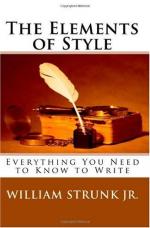|
This section contains 350 words (approx. 1 page at 400 words per page) |

|
In the late 1950s, a war flared between liberal and conservative language authorities. The liberals took a stand against "elitist" notions of "correctness." They argued that actual widespread usage, not prescribed forms, determined the validity of language. This "descriptive" approach to standard English raised the hackles of "prescriptivists," who believed in established roles and a hierarchy of expression.
One such prescriptivist was New Yorker writer and master essayist E. B. White. He condemned the descriptivist view of language as an "Anything Goes" school. Encouraged by a publisher, he entered the fray by updating the stem little handbook of William Strunk Jr., his 1919 English professor at Cornell. Strunk had called his privately printed book The Elements of Style.
White began the new Elements with a paean to Strunk and to the professor's belief in "right and wrong." He added his touch to mundane points of grammar and form...
|
This section contains 350 words (approx. 1 page at 400 words per page) |

|




